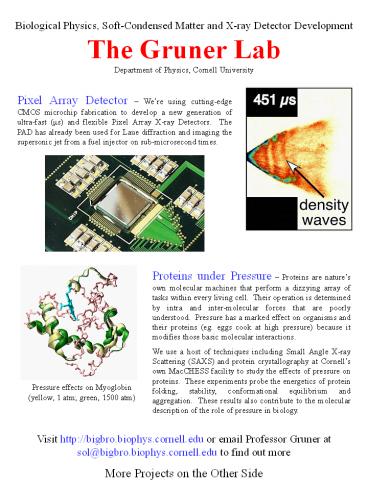Pixel Array Detector - PowerPoint PPT Presentation
Title:
Pixel Array Detector
Description:
... Soft-Condensed Matter and X-ray ... We use a host of techniques including Small Angle X-ray Scattering ... and study their properties with X-ray scattering and ... – PowerPoint PPT presentation
Number of Views:64
Avg rating:3.0/5.0
Title: Pixel Array Detector
1
Biological Physics, Soft-Condensed Matter and
X-ray Detector Development The Gruner
Lab Department of Physics, Cornell University
Pixel Array Detector Were using cutting-edge
CMOS microchip fabrication to develop a new
generation of ultra-fast (µs) and flexible Pixel
Array X-ray Detectors. The PAD has already been
used for Laue diffraction and imaging the
supersonic jet from a fuel injector on
sub-microsecond times.
Proteins under Pressure Proteins are natures
own molecular machines that perform a dizzying
array of tasks within every living cell. Their
operation is determined by intra and
inter-molecular forces that are poorly
understood. Pressure has a marked effect on
organisms and their proteins (eg. eggs cook at
high pressure) because it modifies those basic
molecular interactions. We use a host of
techniques including Small Angle X-ray Scattering
(SAXS) and protein crystallography at Cornells
own MacCHESS facility to study the effects of
pressure on proteins. These experiments probe
the energetics of protein folding, stability,
conformational equilibrium and aggregation.
These results also contribute to the molecular
description of the role of pressure in biology.
Pressure effects on Myoglobin (yellow, 1 atm
green, 1500 atm)
Visit http//bigbro.biophys.cornell.edu or email
Professor Gruner at sol_at_bigbro.biophys.cornell.edu
to find out more More Projects on the Other Side
2
Biological Physics, Soft-Condensed Matter and
X-ray Detector Development The Gruner
Lab Department of Physics, Cornell University
Nanocomposite Self-Assembling Materials Polymers
can be made to spontaneously form into
complicated lattices that should have
applications including catalytic films and
photonic crystals. We make and manipulate these
nanocomposite structures using Block Copolymers
and study their properties with X-ray scattering
and electron microscopy.
CHESS Professor Sol Gruner is director of the
Cornell High Energy Synchrotron Source, a world
class X-ray facility located on campus in Ithaca.
Group members regularly perform experiments at
CHESS and projects are available in
Instrumentation, Materials Science, X-ray Physics
and Accelerator Physics. In addition, plans are
afoot for the Energy Recovery Linac, a
revolutionary new type of X-ray light source.
Protein-Membrane Interactions - The kinetics and
thermodynamics of ion channels and other membrane
proteins depends strongly on the membrane they
are in. Were exploring this dependency with
two techniques. We use liquid crystals to
characterize the properties of various membranes,
and then study ion channel dynamics in those same
membranes with electrophysiology.
Visit http//bigbro.biophys.cornell.edu or email
Professor Gruner at sol_at_bigbro.biophys.cornell.edu
to find out more More Projects on the Other Side































